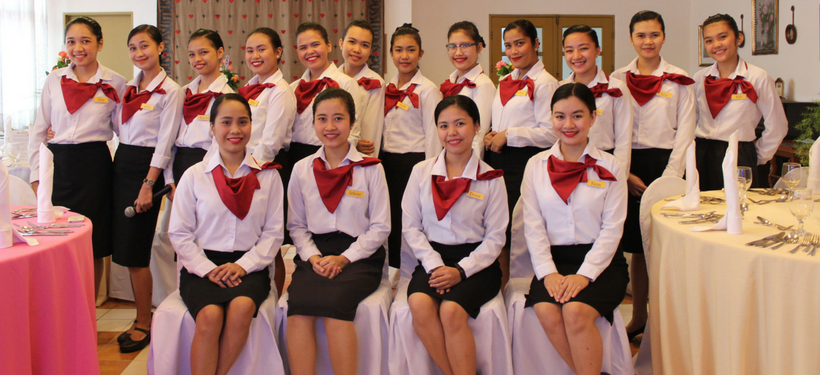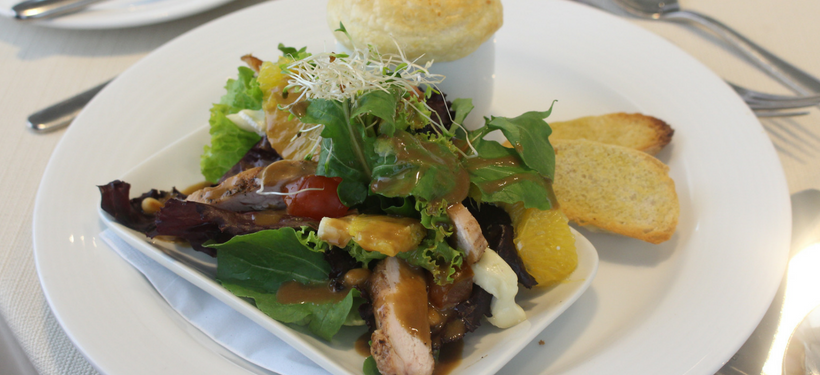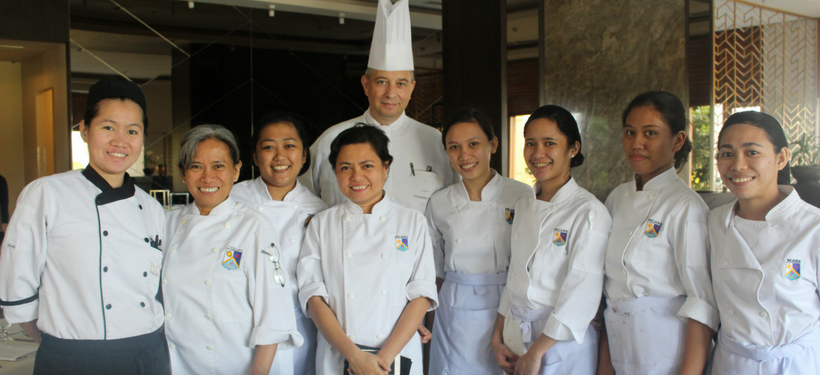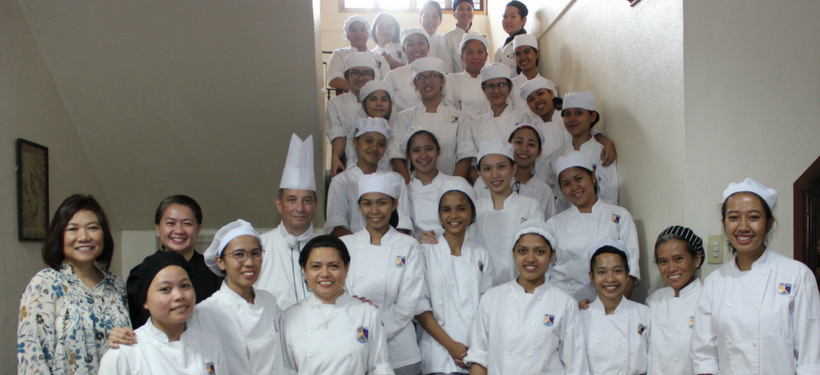
Under the assistance of The Palms Chef Hans Neukom, students of Manila Institute for Culinary Arts and Residential Services (MICARS) prepared and served special dishes last April 7 in their culminating activity entitled Summer Feast. The donation of P2,500 for the lunch is for the scholarship fund of MICARS.
Originally published in MICAR’s website, “Like a Summer Rosé” is Carmita Eliza Icasiano’s detailed account of the recently-held lunch for a cause.
Like a Summer Rosé
Rosé is the term for pink-colored wine produced from the skin contact method, a process where grapes are crushed and left in contact with its skin no longer than twenty hours. When the skin is left to sit longer with the must (pressed grape juice), the result is a more intense color and stronger flavor. Hence, rosé is light to the taste and non-intoxicating.
Almost a result of intelligent design, rosé came to be the wine of choice at Summer Feast, MICARS’ culminating activity held on the 7th of April 2018. MICARS stands for Manila Institute for Culinary Arts and Residential Services, a TESDA-recognized technical-vocational school that offers a two-year certificate program focusing on skills training for culinary arts and hotel/restaurant/residential services. MICARS is managed and owned by the Foundation for Professional Training, Inc., a non-government entity that aims to provide programs for the life-long development of women, enabling them to contribute to the economic, social and cultural development of their families and communities. The special lunch service, held bi-annually, aims to display the students’ skills to prospective and current donors. Lunches in the past have taken for its theme Mediterranean, Italian, the Pacific or Hawaiian, and even, Thanksgiving Day fare. This year’s lunch event brought together some of MICARS’ winning entries to various culinary competitions.ulinary competitions.
Summer Feast transformed a student residence’s living room into a veritable dining room, with eight tables all dolled up with pastel table cloths and floral arrangement on slender glass vases. The set up was replicated in the residence’s dining room where ten other tables were prepped for lunch service. By twelve noon, the guests gathered along the long foyer to be welcomed by MICARS students and staff. After reciting prayers before meals, the guests were led to their assigned tables. Lunch service started promptly and the first course was served; it was Onion with Herbs and Mushroom Soup. The dish is a twist from the French Onion Soup where onions are caramelized until rich and tender. It is then simmered with porcini and mushroom buttons flavored with thyme and rosemary. Delicate pastry dough baked until puffed and flakey covers the soup to keep it warm. This dish merited the silver award in the National Food Showdown of 2013.

What followed was Mesclun Salad with Chicken and Camembert Cheese in Balsamic-Orange Vinaigrette. An assortment of lettuces, fresh orange, cherry tomato, pine nuts and chicken slices enhanced by pureed cashew in balsamic-orange vinaigrette and honey, this salad won the silver from the Philippine Culinary Cup Competition in 2017. Second-year student Irish Dyan M. Frontada executed this dish.
Main entrée came in twos: Gindara with Wine-Tarragon Sauce and Tomato Salsa, and Mustard and Maple Pork Tenderloin with Orange Sauce. The gindara fish or black cod fillet, seasoned with salt and pepper was baked until tender and served with white wine and tarragon sauce, tomato salsa and tomato-flavored couscous. The pork tenderloin, on the other hand, was soaked in brine solution and marinated in mustard-maple syrup. It was wrapped in bacon, roasted until tender, and drizzled with orange sauce. The dish was served with a vegetable potpourri, potato and sweet potato quenelles on the side. Second-year student Harzha T. Loquinto executed this dish and won the bronze at the Philippine Culinary Cup in 2017.
Dessert was a trio of Fruit Vacherin, Lava Cake, and Lemon Pepper Ice Cream, which won the bronze in the First Philippine Chocolate and Ice Cream Show in 2010.
Rosé could not have been a more appropriate pairing for the lunch service. Not only because it perfectly accompanied the dishes but also since rosé embodies qualities that parallel MICARS and Summer Feast. For one, rosé is light and mild for a meal accompaniment. It suited the three-course, seven-item menu. In the same way, MICARS students are known to integrate effectively in any work environment. Chef Hans Neukom of The Palms Country Club, who assisted in the preparation of the dishes, attests to the performance of MICARS students and lauds their openness and capacity for teamwork. He also praised their dedication and passion to learn from their workmates and overall work experience.

Rosato in Italy, rosado in Portugal and Spanish-speaking countries, the story of rosé is one of adaptation, invention and success. Rosé’s presence in Europe is well-established as its production process is similar to that of the earliest red wines when winemaking techniques involved pressing soon after harvest. For this reason, the earliest red wines were closer in color to modern rosé. For most of the 20th century, sparkling rosés gained prominence in European and American markets, and dominated the Portuguese wine industry. Alongside rosés is the American “blush,” a wine category that refers to pinker, sweeter wines. Its origin is an outcome of an unintended invention when in 1975, Sutter Home’s “white zinfandel” wine ran into a yeast fermentation problem when the yeast failed to turn all the sugar into alcohol. Sutter Home’s Bob Trinchero put it aside for a couple of weeks, and after tasting the pinker, sweeter wine, decided to sell it. The following year, wine writer Jerry D. Mead visited Mill Creek Vineyards in Sonoma County where the Cabernet Sauvignon vines were first planted in California. Mead was offered a wine made from Cabernet that was a pale pink which was yet unnamed. Later in the day, Mead stumbled upon the name “Cabernet Blush”. The word “blush” was trademarked two years later. Blush managed to undercut rosé’s market shares in the present century. Today, blush wine appears in wine lists more as a category, rather than a specific wine. The term rosé continues to hold a presence in the European and US markets. It has surpassed the blush, which in North America now refers to relatively sweet wine. In Europe, almost all pink wines are referred to as rosé regardless of sugar levels. In 2005 an increased production in California crop compelled winemakers to make rosé rather than leave their reds unsold.
Like rosé and its erstwhile rival, blush, the MICARS student moves along a spectrum of adaptation, invention, and success. Mostly from provincial towns in the Philippines, she migrates to Manila, learns to socialize, and blend with the cultures of the city and MICARS education. It is in this newfound environment that she transforms and reinvents herself. Upon graduation and after gaining the competencies and confidence required to perform as a team player in different work settings, she once again enters into the cycle of adaptation and reinvention, to eventually see her dreams fulfilled or at the very least, see the way to realizing them.

The success of the MICARS student is a co-production. It is a result of the combined agencies of MICARS faculty and staff, students and graduates, her parents and family, patrons, donors, and industry partners. Events like Summer Feast highlight meaningful collaboration like this. Just as Chef Hans stated, the culminating activity is for the MICARS student. “We take their talent and help the girls realize their dream. It is hard to realize a dish. We just help them materialize their dreams. The lunch is really about them, not about us. It’s showing us what they can do.”
And show them, the MICARS graduates have done. Since the earliest years, MICARS graduates have found gainful employment both in local and international properties. They have done their school, family, and donors proud. In these times of uncertainties political and social, environmental and cultural, the success of the MICARS student comes sweet like a summer rose, just like Summer Feast which ran right into the start of the dry season. Delightfully fresh and hopeful with a blush.
